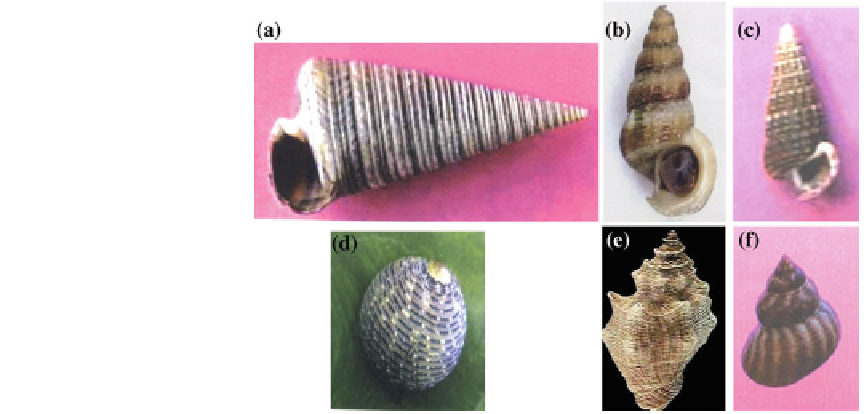Environmental Engineering Reference
In-Depth Information
from the ocean as well as the atmosphere.
This aspect will become more important as
global warming and ocean carbon capacity
affect the amount of carbon absorbed by
oceans. A direct comparison between biose-
questration activities and shell
carbon content
in shell and
fl
eshy part are
available till date.
T. telescopium
are often seen grazing on the
intertidal mud
ats creating unique trail marks
(Fig.
6.15
). These gastropod species depend on
carbon enriched detritus of the intertidal mud
fl
sh farming
may be unrealistic as the former is under-
pinned by photosynthesis and the latter by
respiration. An independent assessment of the
shell
ats
and form a unique carbon dynamics in the ben-
thic substratum of the coastal zone.
Carbon in gastropod shell carbonate originates
from four important sources: atmospheric carbon
dioxide, food, water and carbonate rocks. Gastro-
pods incorporate atmospheric carbon dioxide in
their shell carbonate via respiration. Respired car-
bon dioxide is introduced to the bicarbonate pool in
the gastropod
fl
sh industry is essential to determine the
magnitude of carbon sequestration (where all
the stages of oyster life cycle need critical
analyses). Such assessment may form the
basis of the overall costs of generating carbon
offsets through oyster farming.
s haemolymph and passed along to
the extrapallial
'
uid, from which the shell carbon-
ate is ultimately precipitated (Wilbur
1972
). Esti-
mates of the contribution of atmospheric carbon
dioxide to gastropod shell carbonate vary between
negligible (Stott
2002
), 16
fl
6.2
Stored Carbon in Gastropods
Gastropods play a signi
cant role both in accu-
mulation and circulation of carbon, especially in
habitats where they are numerous and their bio-
mass is high, but studies concerning these prob-
lems are scarce. In the intertidal mud
48 % (Romaniello et al.
-
2008
)and30
60 % (Goodfriend and Hood
1983
).
Carbon from food sources (e.g., living plants,
fungi, organic detritus) is incorporated into the
extrapallial
-
fl
ats of
uid through two mechanisms: direct
digestion and breakdown of urea. Many gastro-
pods (like
fl
mangrove-dominated Sundarbans,
gastropods
like
,
Cerithedia cingulata, Cymia lacera, Littorina
scabra scabra
Telescopium telescopium
,
Nerita articulata
sp.) feed on mangrove leaves
(Fig.
6.16
), and even some (like
Littorina
) scrap
the algae that deposit on the trunk of mangroves
(Fig.
6.17
).
C. obtusa
are abun-
dantly distributed (Fig.
6.14
), but no data on their
and
Cerithedia obtusa
Fig. 6.14
The dominant
gastropod species in
mangrove-dominated
Indian Sundarbans.
a
Telescopium telescopium.
b
Cerithedia obtusa.
c
Cerithedia cingulata.
d
Nerita articulata.
e
Cymia lacera.
f
Littorina
spp


